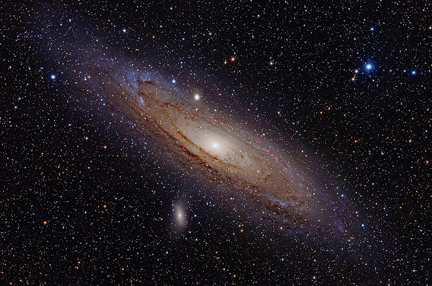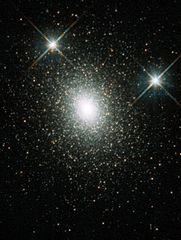
December 2018 - Vol. 22, No. 11
This Month's Night Sky - NOTE: The next paragraph describes the sky as it appears at 10 pm EST (11 pm EDT) near mid- month. The sky also looks this way at 11 pm EST (midnight EDT) during the beginning of the month and at 9 pm EST (10 pm EDT) by month's end.
Sirius (Canis Major), the brightest star in the night sky, shines brilliantly in the South. It forms the bottom leg of the Winter Triangle. The triangle's upper stars are reddish Betelgeuse (Orion) to the right and whitish Procyon (Canis Minor) on the left. Capella (Auriga) appears directly overhead later in the evening and you might even glimpse Canopus (Carina) very low (below Sirius) in the South. Looking North you will find the "Big Dipper" (Ursa Major) with its handle still pointing towards the horizon. Cassiopeia's famous "W" asterism is high in the Northwest and Regulus (Leo) shines in the East. Don't forget to look for Castor and Pollux (Gemini "twins") above the Winter Triangle.
MERCURY will be visible in the evening sky this month, its position somewhat favoring northern observers. It reaches conjunction with the red planet on the 21st. VENUS shines brightly in the morning twilight sky. MARS' ends 2018 at magnitude +0.5 at 7.4" in diameter, moving from Aquarius into Pisces this month. A fine conjunction with NEPTUNE occurs on the 7th. JUPITER reappears in the morning twilight making a final 2018 appearance. SATURN will not be seen as it approaches conjunction with the Sun early next year. URANUS sets before midnight..
Review how to determine Angular Measurement.
Calendar of Events
NOTE: For those observers not in the ET zone, convert the calendar times to your zone's time by subtracting one hour for CT, two for MT and three for PT. Don't forget to adjust for Daylight Savings Time when necessary by subtracting one hour from your planisphere's time. Dawn and dusk times must also be corrected. See your local newspaper, TV news, or cable TV's Weather Channel for sunrise and sunset times or check with the U.S. Naval observatory. Unfortunately some of these events may occur during daylight hours in your area.
| DATE | EVENT |
| 02 | Venus at greatest extent illumination. (-4.9 mag.) |
| 03 | Venus 4 deg. S. of Moon. |
| 04 | Mercury 1.9 deg. S. of Moon. |
| 05 | Mercury 1.9 deg. S. of Moon. |
| 07 | Mars .04 deg. N. of Neptune. |
| 09 | Saturn 1.1 deg S. of Moon, occultation from SE Russia, N. tip of China. |
| 10 | Pluto 0.7 deg S. of Moon, occultation from NE China, E. Mongolia, Japan, parts of Russia, N. Micronesia and the Aleutian Islands. Aperture will be required to view this event! |
| 12 | Moon at apogee. |
| 14 |
Geminid meteor peak. This meteor shower is unusual in that it is associated with the 3200 Phaethonan asteroid that orbits the Sun every 1.4 years. Most showers are associated with periodic comets. The Geminid shower is one of the most prolific meteor shower that may produce about 120 meteors per hour at its peak. Best observed after midnight. |
| 18 | Mars 4 deg. N. of Moon. |
| 21 | Mercury 0.9 deg. N of Jupiter, the two planets may fit in a wide angle field and present a variation of color and brightness. A little dance might impress earthbound observers with the observation that, yes, the planets of the solar system are in motion. Aldebaran 1.7 deg. S. of Moon. Winter solstice for the north hemisphere will complement Summer solstice for the south. |
| 22 | Ursid meteor shower peak. This shower produces up to 10 meteors per hour, the full Moon will interfere with observations this year. |
| 24 | Moon at perigee. |
| 25 | Moon .6 deg. S. of Beehive cluster (M-44). |
| 26 | Venus at perihelion. |
Lunar Almanac for December 2018
| Phases of the Moon | Phase and Date(s) | Best viewed before local midnight |
 |
New 07 |
Deep Space Objects |
 |
1st. Qtr 15 |
Planets & Moon |
 |
Full 22 |
Moon |
 |
Last Qtr 29 |
Deep Space & Planets |
Topic of the month: Andromeda Galaxy (M-31)
On a clear night, under a dark fall sky, observers in the northern hemisphere can find the most distant object clearly visible by the naked eye. On special nights when conditions are just right, the unaided eye might spot the distant galaxy like a cloud, stretching the diameter of 6 full moons across the sky. This is one of those sights that we say, "Once you have seen it, you can't unsee it!" It is so obvious that it can also be seen in a light-polluted urban sky as long as it is not in some bright spotlight.

Duly noted by ancient astronomers, the galaxy was given an M number by Charles Messier and so it is also known as "M-31." Andromeda is a companion of the Milky Way galaxy, along with the spiral known as M-33 in the nearby constellation of Triangulum. These 3 large spirals, along with many dwarf galaxies are bound together and known today as the "Local Group." As can be seen in the image of Andromeda, two nearby companions known as M-32 and NGC-205 are among the most obvious. By 2016, a total of 31 dwarf galaxies have been identified. Half of these dwarves are are orbiting in a plane, a strange configuration that is being studied to improve our understanding of galaxy formation.
This image of Andromeda M-33 was taken by Adam Evans and is licensed under Creative Commons (CC by 2.0) via Wikimedia Commons. URL: https://creativecommons.org/licenses/by/2.0 This image has been edited to fit on this website. Here is the original description: The Andromeda Galaxy is a spiral galaxy approximately 2.5 million light-years away in the constellation Andromeda. The image also shows Messier Objects 32 and 110, as well as NGC 206 (a bright star cloud in the Andromeda Galaxy) and the star Nu Andromedae. This image was taken using a hydrogen-alpha filter. Page URL: https://commons.wikimedia.org/wiki/File:Andromeda_Galaxy_(with_h-alpha).jpg
Our companion galaxy has been poked and prodded by astronomers through the ages. Early observers were unable to determine its distance or composition. It was merely a "star cloud". In 1924 cepheid variables were used to give a distance of 1.5 million light years, proving finally that Andromeda existed outside our own Milky Way. Today we have estimated that the number of distant galaxies far exceeds the number of stars in the Milky Way. As advances have been made in astronomy, the latest measurement says Andromeda is about 2.5 million light-years away. Of course it may depend on which side you are looking!
 The Andromeda galaxy is massive, showing a point-like central core that has actually been resolved into a double nucleus. It is believed to be over 220,000 light-years in size. One of the earliest clues that Andromeda was more massive than the Milky Way was the fact that M-31 has a large number of globular clusters, many more than identified or estimated for the Milky Way. (Because of the structure of our galaxy, many objects are hidden from our view by spiral arms, dust and gas.) The number of globulars is always changing, but 450 or more have been detected.
The Andromeda galaxy is massive, showing a point-like central core that has actually been resolved into a double nucleus. It is believed to be over 220,000 light-years in size. One of the earliest clues that Andromeda was more massive than the Milky Way was the fact that M-31 has a large number of globular clusters, many more than identified or estimated for the Milky Way. (Because of the structure of our galaxy, many objects are hidden from our view by spiral arms, dust and gas.) The number of globulars is always changing, but 450 or more have been detected.
Andromeda is a spiral that is tilted 15-degrees toward Earth in the Milky Way. Because of this angle, it is difficult to really map out the shape of the Andromeda spiral. It is classified as SA, but it is now believed that Andromeda actually is a barred spiral. (SB) Many of its globulars are within reach of an amateur telescope - - at least 10" scope is needed. The easiest to detect is the globular G1 (also known as Mayall II.) At magnitude 13.7, it is believed to be the brightest globular in the Local Group. Information about making observations of Andromeda's globulars can be found on the internet. The image posted here was taken by Hubble Space Telescope and is courtesy NASA and ESA.
Find Andromeda by first locating the "Great Square of Pegasus." This time of year it is climbing up from the eastern horizon. It really appears like a square. One star in the top right corner of the Square has been designated at Alpha Andromedea. This is where we start our search for the great nebula of Andromeda. You can star hop to the second star over from Alpheratz in the diagram, Mirach or Beta And. Follow the line up toward the 3.9 magnitude star Mu And. Actually, if it is a suitably dark site, Andromeda will shine out at you like a small cloud.

One last thing, the Milky Way is believed to be heading for a collision with Andromeda. Don't let it worry you too much - - that meeting is scheduled for 4 billion years from now.
--See You Under the Stars!
Astra for Astra's Almanac
The star chart above was generated by Stellarium, a free open source planetarium program. The above image was created by Dawn Jenkins, using Stellarium and a graphic editing program to format the image for this web page.
This installment of "What's Up?" is ©2018 by Dawn Jenkins for Astra's Stargate. View Ron Leeseburg's Farewell Issue for information on where to find information such as is presented in this almanac.